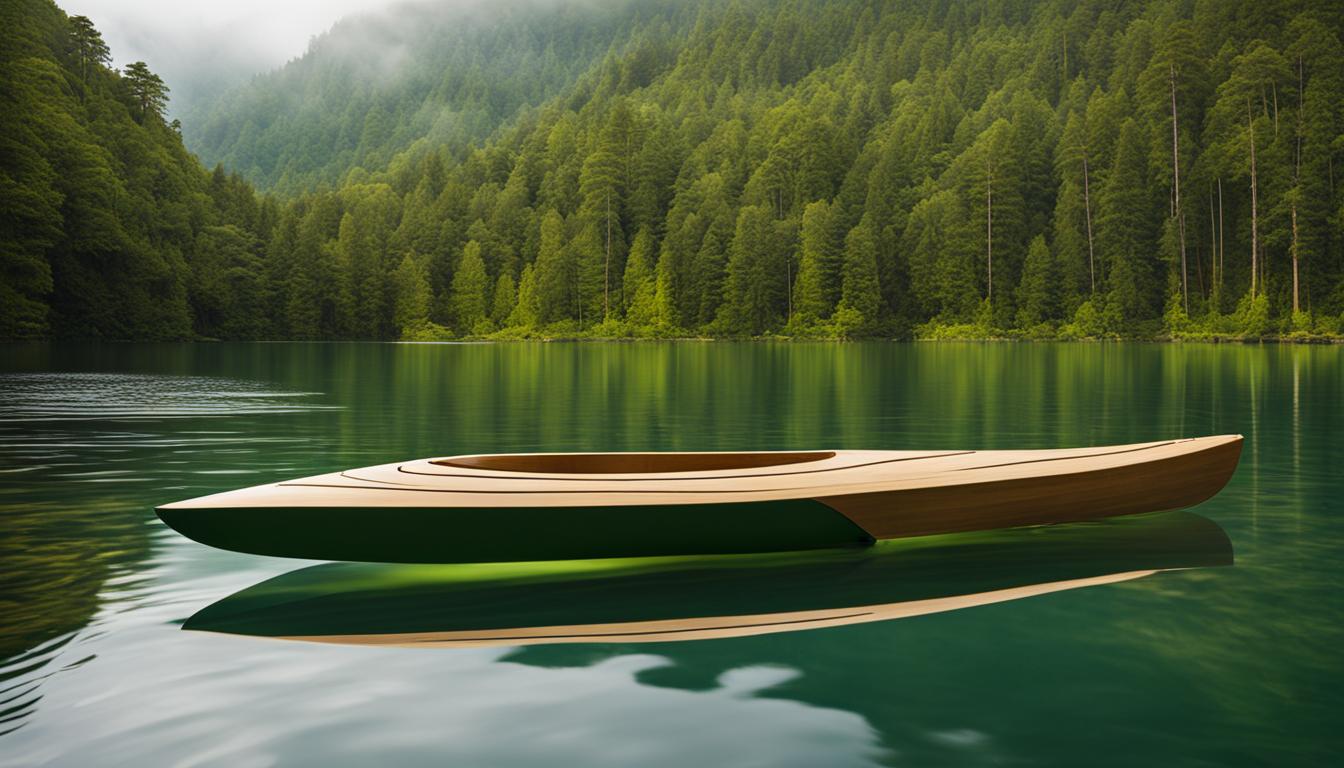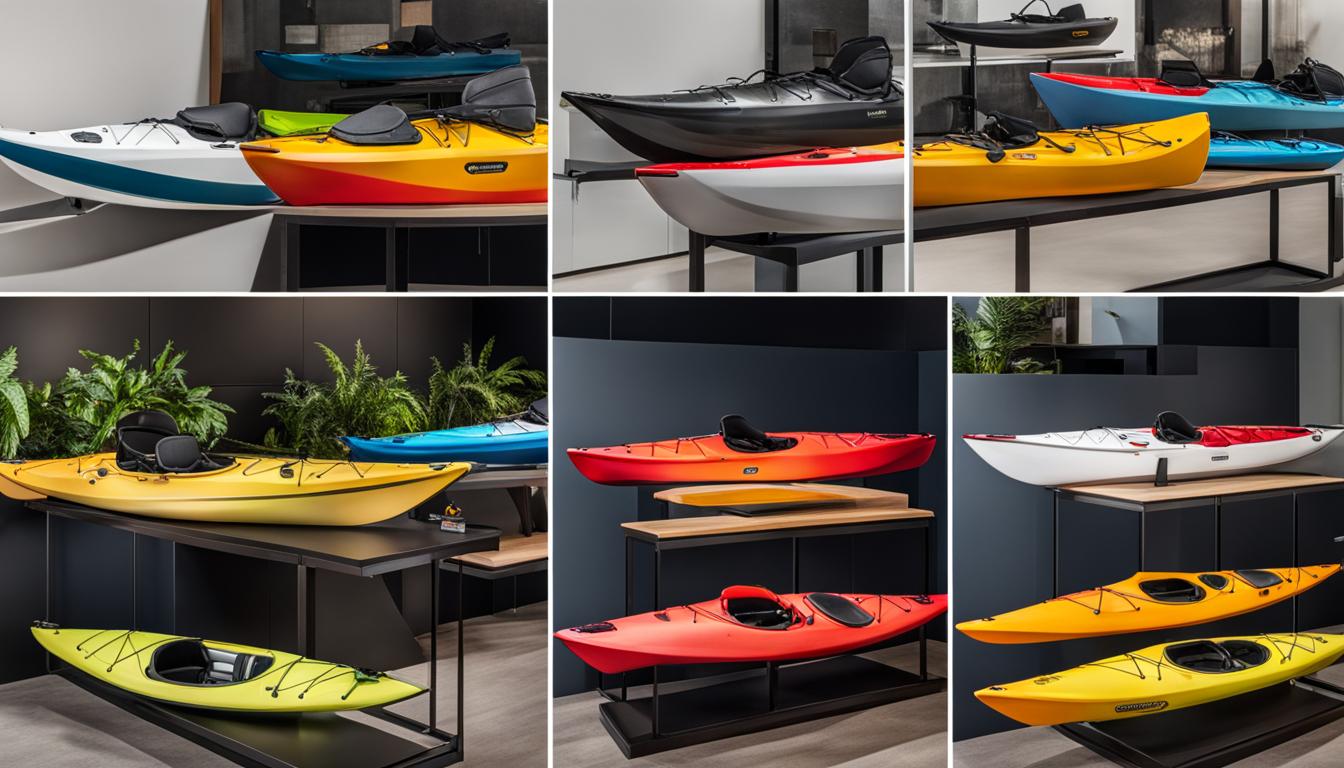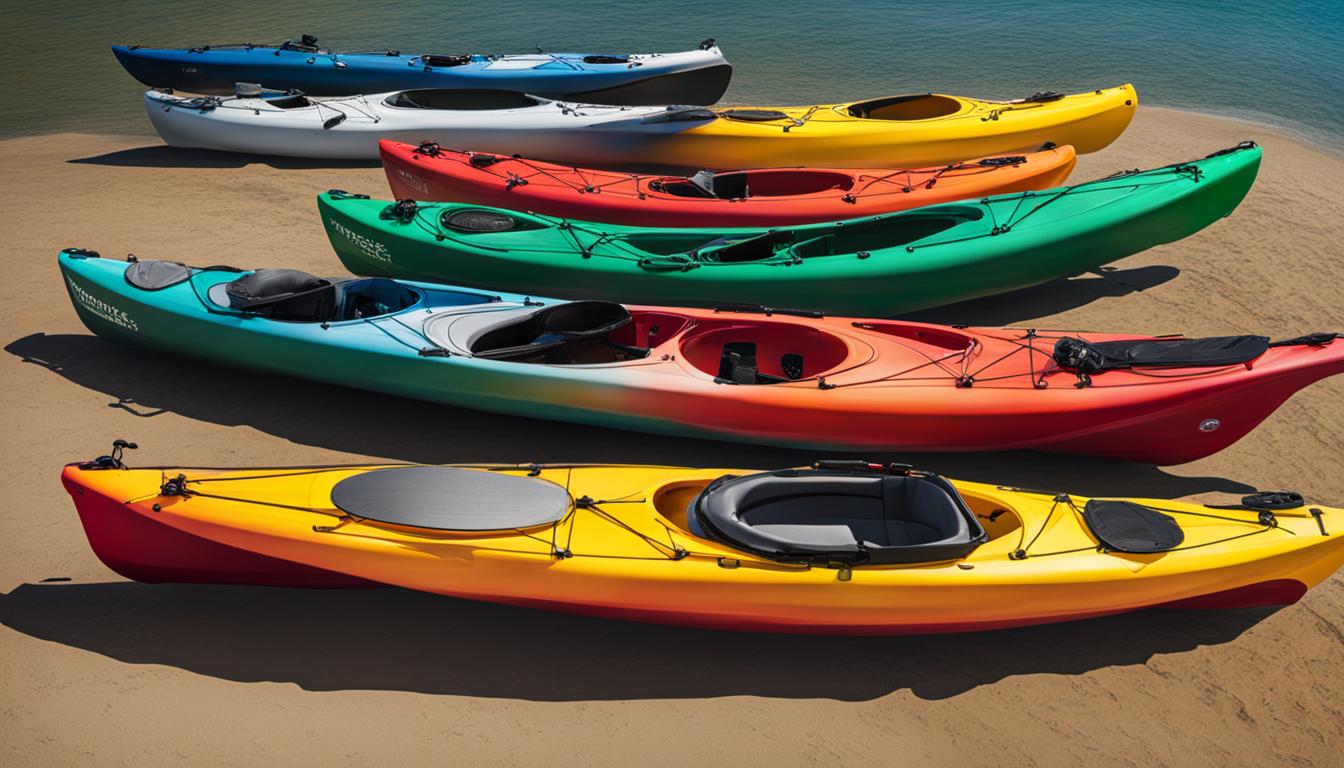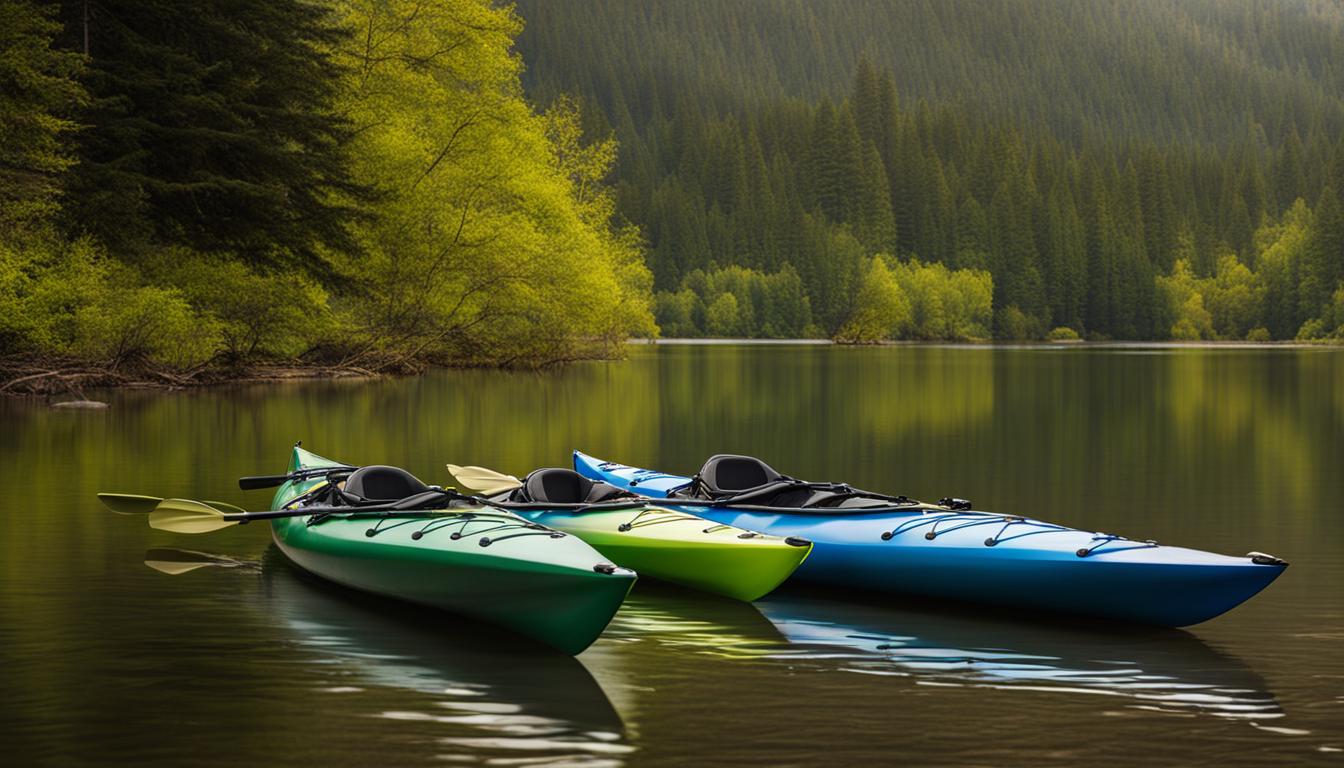Kayak materials play a crucial role in determining the performance, durability, and environmental impact of a kayak. When it comes to eco-friendly options, Eddyline and Delta are leading the way with their sustainable practices and commitment to using environmentally conscious materials. By choosing kayaks made from these eco-friendly materials, you can enjoy your paddling adventures while minimizing your impact on the environment.
At Eddyline, they prioritize the use of eco materials in their kayak designs. Their manufacturing process incorporates green initiatives such as waste reduction, material recycling, and the use of low-VOC coatings. This ensures that their kayaks not only perform well but also have a minimal environmental footprint. Consider Eddyline if you’re looking for kayaks that combine sustainability and high-quality craftsmanship.
Delta Kayaks is another brand that stands out for its sustainable practices. They employ advanced environmental kayak technology, including efficient hull designs and sustainable material choices. This allows them to minimize their carbon footprint while producing high-performance kayaks that meet the needs of eco-conscious paddlers. If you’re looking for kayaks that prioritize sustainability without compromising on performance, Delta is a great choice.
Key Takeaways:
- Eddyline and Delta are kayak manufacturers that prioritize eco-friendly materials and sustainable practices.
- Eddyline implements green initiatives, such as waste reduction and material recycling, in their manufacturing process.
- Delta utilizes advanced environmental kayak technology to reduce their carbon footprint.
- Choosing kayaks made from eco-friendly materials allows you to minimize your impact on the environment.
- Eddyline and Delta offer a range of options for eco-conscious paddlers without compromising on performance.
Materials for Hard-Shell Kayaks
When it comes to hard-shell kayaks, there are several different materials to consider. Each material has its own unique characteristics and advantages, allowing paddlers to choose the kayak that best suits their needs and preferences.
Rotomolded polyethylene kayaks
Rotomolded polyethylene is one of the most popular materials used for hard-shell kayaks. This material is known for its durability, making it resistant to impacts and capable of withstanding rough conditions. It is also relatively affordable compared to other options, making it a great choice for budget-conscious paddlers.
Thermoform kayaks
Thermoformed kayaks offer a middle ground between rotomolded polyethylene and composite kayaks. These kayaks are made by heating a plastic sheet and then vacuum-forming it into the desired shape. Thermoform kayaks are lighter in weight compared to rotomolded polyethylene, making them easier to handle and transport. They also have a sleeker aesthetic, resembling the look of composite kayaks, but at a more affordable price point.
Composite kayaks
Composite kayaks are known for their high performance and lightweight construction. They are made from materials such as fiberglass, aramid fibers (like Kevlar), and carbon fiber. Composite kayaks offer excellent speed and agility on the water, making them a popular choice among experienced paddlers. However, they tend to be more expensive than other options due to the advanced materials used in their construction.
Wooden kayaks
For those looking for a unique and customizable option, wooden kayaks provide a DIY project that results in a beautiful and functional watercraft. Wooden kayak kits are available for purchase, allowing paddlers to build their own kayaks using techniques such as strip-planking or stitch-and-glue. Wooden kayaks offer a classic look and can be personalized with different wood types and finishes.
Polycarbonate kayaks
Polycarbonate kayaks are known for their excellent impact resistance, making them suitable for navigating rough waters. These kayaks are designed to withstand collisions with rocks and other obstacles, ensuring they remain durable and reliable over time. Polycarbonate kayaks are a great option for paddlers who seek adventure and need a kayak that can handle challenging conditions.
Choosing the right material for your hard-shell kayak is an important decision. Consider factors such as durability, weight, performance, and cost when making your choice. Whether you opt for the affordability and toughness of rotomolded polyethylene, the lightweight and sleek design of thermoform kayaks, the high performance of composite kayaks, the DIY appeal of wooden kayaks, or the impact resistance of polycarbonate kayaks, there is a material that will suit your needs and provide a great paddling experience.
| Kayak Material | Pros | Cons |
|---|---|---|
| Rotomolded Polyethylene | Durable, affordable | Heavier, less sleek |
| Thermoform | Lightweight, sleek aesthetic | More expensive than polyethylene |
| Composite | High performance, lightweight | Expensive |
| Wooden | Customizable, unique look | Requires DIY construction |
| Polycarbonate | Excellent impact resistance | Can be more expensive |
Inflatable and Folding Kayak Materials
When it comes to portable and convenient kayaking options, inflatable and folding kayaks take the spotlight. These innovative designs offer versatility and ease of transportation, making them popular choices among paddlers. Let’s take a closer look at the materials used in inflatable and folding kayaks.
Inflatable Kayaks
Inflatable kayaks are typically constructed using durable materials such as PVC (Polyvinyl Chloride) or Hypalon. These materials provide excellent resistance to abrasion and punctures, ensuring the kayak’s longevity. PVC is a versatile material known for its strength and affordability, making it a popular choice. Hypalon, on the other hand, is a synthetic rubber known for its resistance to UV rays and harsh environmental conditions, making it a durable option for inflatable kayaks.
| Material | Pros | Cons |
|---|---|---|
| PVC | Affordable | Less UV resistant compared to Hypalon |
| Hypalon | UV and abrasion resistant | Higher cost |
Folding Kayaks
Folding kayaks are designed for easy assembly and transportation, offering a compact and lightweight option for adventurous paddlers. These kayaks are typically made with lightweight yet strong materials such as aluminum or carbon fiber frames, providing stability and durability. The kayak’s skin, which covers the frame, is crafted from a durable material that can withstand water exposure and provide buoyancy.
“Folding kayaks offer the best of both worlds – the convenience of portability and the performance of a traditional kayak.”
When choosing between inflatable and folding kayaks, consider your specific needs and preferences. If you value easy setup, compact storage, and portability, inflatable kayaks are an excellent choice. On the other hand, if you prefer the performance and feel of a traditional kayak with the added benefit of easy transportation, folding kayaks offer a reliable and durable option.
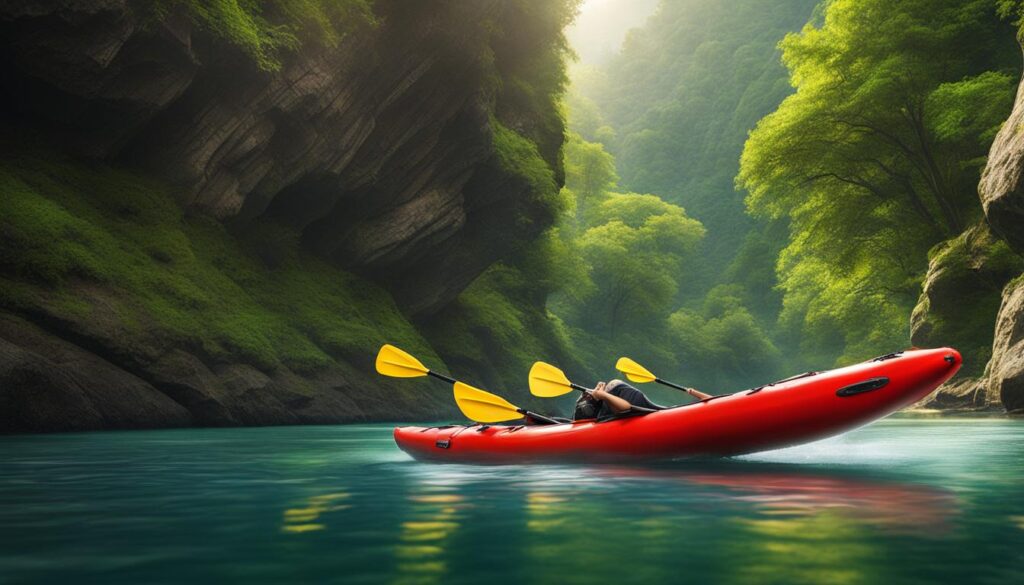
In the next section, we will explore the environmental impact of different kayak materials and how kayak manufacturers are implementing eco-friendly practices to minimize their footprint.
The Environmental Impact of Kayak Materials
When it comes to choosing a kayak, it’s important to consider not only the performance and durability but also the environmental impact of the materials used. Eddyline and Delta, two leading kayak manufacturers, are committed to offering eco-conscious designs and minimizing their carbon footprint. Let’s take a closer look at their green initiatives and environmental kayak technology.
Eddyline Green Initiatives
Eddyline is dedicated to producing kayaks with minimal environmental impact. They have implemented several green initiatives throughout their manufacturing process. One of their key focuses is on reducing waste by optimizing material usage and recycling any excess materials. By doing so, they are able to minimize the amount of waste that ends up in landfills.
In addition to waste reduction, Eddyline also uses low-VOC (Volatile Organic Compound) coatings, which have a lower environmental impact compared to traditional coatings. These coatings not only provide excellent protection but also contribute to better air quality during the manufacturing process.
Delta Environmental Kayak Technology
Delta Kayaks is another brand that prioritizes eco-responsible kayaking. They have developed advanced environmental kayak technology to minimize their carbon footprint. One of their key strategies is to focus on efficient hull designs that reduce drag and increase overall efficiency. By optimizing the shape and contours of their kayaks, Delta is able to reduce energy consumption without compromising performance.
Furthermore, Delta utilizes sustainable material choices in their kayak construction. They carefully select materials that have a lower environmental impact, such as recycled plastics and bio-based alternatives. This not only reduces the demand for virgin materials but also helps to conserve natural resources.
| Eddyline Green Initiatives | Delta Environmental Kayak Technology |
|---|---|
| Waste reduction through optimized material usage and recycling | Efficient hull designs to minimize drag and increase efficiency |
| Use of low-VOC coatings for better air quality | Sustainable material choices, including recycled plastics and bio-based alternatives |
By opting for kayaks from Eddyline and Delta, paddlers can enjoy their water adventures with confidence, knowing that they are making a sustainable choice. Both brands are leading the way in eco-conscious kayak designs and are dedicated to minimizing their environmental impact. So, whether you’re a seasoned paddler or just starting out, consider choosing a kayak that not only meets your needs but also contributes to a greener and more sustainable future.
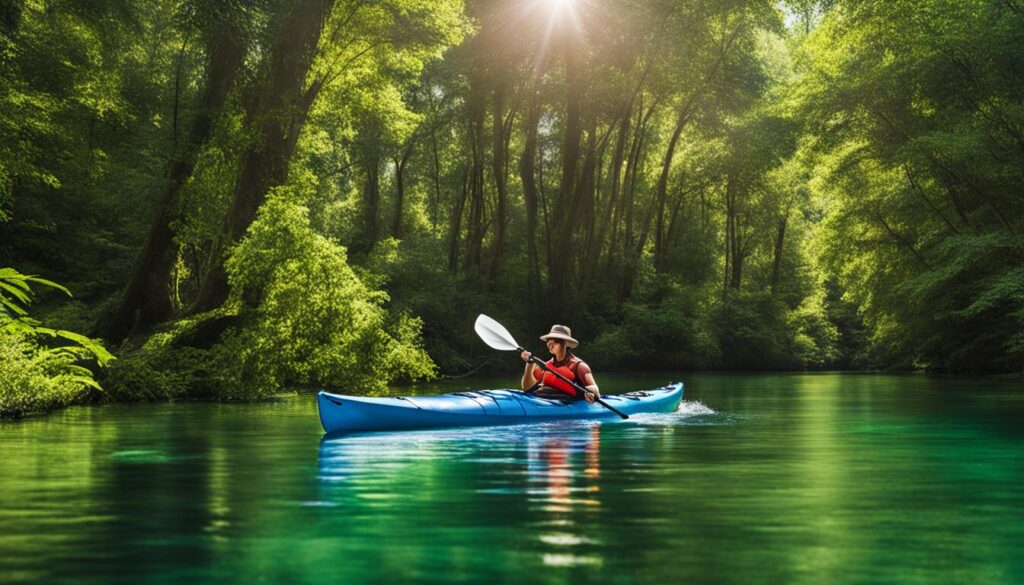
Eco-conscious kayaking is not just about enjoying the beauty of nature, but also taking responsibility for its preservation. By choosing kayaks made with sustainable materials and supporting brands like Eddyline and Delta, you can be part of the solution and make a positive impact on the environment.
Conclusion
When it comes to sustainable paddling, Eddyline and Delta are leading the way with their eco-friendly kayak materials. Each brand offers a range of options that cater to different needs and preferences, ensuring that you can enjoy your kayaking adventures while minimizing your impact on the environment.
Comparing Eddyline and Delta, you’ll find that both prioritize eco-conscious designs and practices. Eddyline implements green initiatives in their manufacturing process, focusing on waste reduction, material recycling, and low-VOC coatings. Delta, on the other hand, utilizes advanced environmental kayak technology, including efficient hull designs and sustainable material choices, to reduce their carbon footprint.
When it comes to kayak materials, Eddyline and Delta provide a variety of choices. Eddyline offers rotomolded polyethylene kayaks, known for their durability and affordability. Delta, on the other hand, provides options like thermoformed kayaks, which combine the benefits of plastic affordability with lighter weight and sleek aesthetics of composites.
Whether you choose the high-performing composite kayaks, the customizable wooden kayaks, or the portable and convenient inflatable kayaks, both Eddyline and Delta have eco-friendly options to suit your preferences. By prioritizing sustainable materials and environmentally responsible practices, these brands pave the way for a greener paddling experience.
FAQ
What are the different materials used for hard-shell kayaks?
Hard-shell kayaks can be made from rotomolded polyethylene, thermoform, composite materials like fiberglass and carbon fiber, wood, or polycarbonate.
What are the advantages of rotomolded polyethylene kayaks?
Rotomolded polyethylene kayaks are known for their durability and affordability.
What are the benefits of thermoform kayaks?
Thermoform kayaks offer a mid-range option, combining the affordability of plastic with the lighter weight and sleek aesthetics of composites.
What are the advantages of composite kayaks?
Composite kayaks, made from materials like fiberglass, aramid fibers, and carbon fiber, are lightweight and high-performing but more expensive.
What are wooden kayaks?
Wooden kayaks are often DIY projects, offering a unique and customizable option.
What are polycarbonate kayaks suitable for?
Polycarbonate kayaks provide excellent impact resistance, making them suitable for rough conditions.
What are inflatable kayaks made from?
Inflatable kayaks are typically made from durable materials like PVC or Hypalon.
What are folding kayaks made from?
Folding kayaks are made from lightweight and strong materials like aluminum or carbon fiber frames with a durable skin.
How do Eddyline and Delta prioritize eco-friendly materials?
Eddyline implements green initiatives in their manufacturing process, such as reducing waste, recycling materials, and using low-VOC coatings, while Delta utilizes advanced environmental kayak technology and sustainable material choices.
What are the benefits of choosing eco-conscious kayak designs?
Choosing eco-conscious kayak designs allows paddlers to enjoy their water adventures while minimizing their impact on the environment.

